Education and Outreach
2014 2013
2012 2011 2010
2009 2008 2007
2006 2005 2004
2003 2002 2001
2013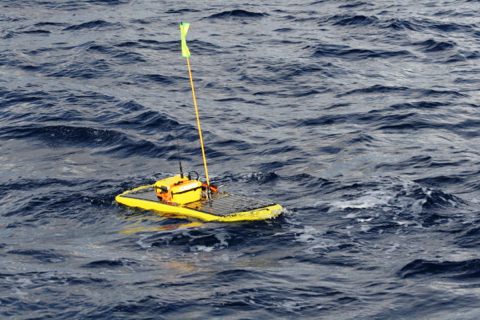
Our eighth annual March stint with Cornell University’s interdisciplinary Ocean Resources and Ecosystems Program took an exciting turn this year. In collaboration with Jupiter Research Foundation, and with visiting scientist Dean Hawthorne from Cornell’s Bioacoustics Research Program, this year’s focus was on combining theodolite tracking with acoustic tracking using Wave Gliders. Board member Adam Frankel wasn’t able to be in the field this year, so board members Chris Gabriele and Suzanne Yin provided classes on humpback whale biology and field techniques to the Cornell students. They also led the student field team to visually track a singing whale that Dean could hear via the Wave Gliders, for over an hour. 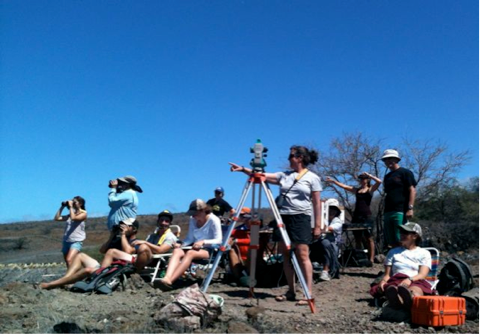
This summer, with some coaching from Adam as well as from Beth Goodwin of Jupiter Research Foundation, two of the students (Katherine Kirk and Michael Walsh) worked up the data as their independent study project for the class. Adam’s talk about our work generated much interest at the 20th Biennial Conference on the Biology of Marine Mammals in Dunedin, New Zealand in December 2013. Way to go Kathleen, Michael and Adam! We look forward to continuing this collaboration in 2014.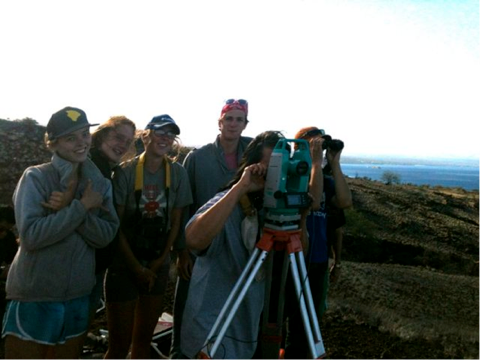
In 2013, HMMC shared our work in Hawai‘i with various audiences. Chris gave a talk to board member Susan Rickard’s 10th grade Animal Behavior class at Parker School in Waimea; the 1st grade class also tagged along. In January - March, we talked with visitors at several of the Sanctuary-sponsored whale spotting sessions at Pu‘ukohola Heiau National Historic Site.
2012
On Tuesday, February 14th, HMMC board member Suzanne Yin presented a talk at Parker School to Susan Rickards' marine science class. Yin spoke for about 45 minutes about tracking bowhead whales from the ice with a theodolite, techniques very similar (except for the ice) to those used by the HMMC for their shore station scans during February and March. Thanks to Parker School for the opportunity to give this talk.
On Tuesday, March 6, HMMC board members Adam Frankel, Chris Gabriele and Yin attended the monthly Hawaiian Islands Humpback Whale National Marine Sanctuary meeting led by Justin Viezbicke in the conference room of the National Energy Lab of Hawai‘i. The group answered several questions about humpback ecology, distribution and seasonal abundance and displayed their fluke poster. Thanks to Justin for having us!
On Friday, March 9, Chris and Yin attended the weekly humpback whale watch at the Pu‘u Kohola Heiau led by Justin Viezbicke. When Justin was called away to monitor an entangled monk seal, Chris and Yin assisted the local docents by answering questions about marine life, pointing out whales to local residents and tourists and providing information about humpback whales, turtles and blacktip reef sharks. The day started off very calm and at least eight blacktip reef sharks could be seen from the visitor's center.
On Wednesday, March 14, Chris gave a ReefTalk at the Thelma Parker Memorial Library in Waimea, titled "Missing the Boat: Understanding Whale Vessel Collisions in Alaska". Some important information for boaters to avoid whale collisions were given. If you missed the talk, you can see a summary of the main points in the February 2012 newsletter of the Alaska Marine Safety Education Association. Mahalo to Sara Peck for the invitation to speak, and Chantal Chang for carrying forward the Reef Talk tradition after Sara's retirement.
For the 7th year in a row, Adam led the bioacoustics portion of the Cornell University field quarter. Students heard lectures on humpback whale ecology and song, and participated in several laboratory exercises. On Saturday, March 10th, the class visited the shore station at Mile Marker 7, where Chris, Adam and Yin demonstrated shore station techniques. Topics included how to use a theodolite, compass-bearing reticle binoculars and a computer from the last century (our trusty, but old Apple Wallstreet laptop) as well how to collect data for a shore station scan. During the class' whale watch on March 13th, the group made a recording of a singer and took photos of the whale's flukes. This whale turned out to be one of the famous 53 whales featured on the HMMC fluke poster. A mother/calf pair was also seen and photographed.
This year, two college students from the Cornell University field quarter participated as interns with the HMMC. One of the main research goals for the HMMC for the past several years has been to determine the size of singing humpback whales. With a laser-range finder, digital photography and excellent driving skills, images can be obtained to determine the width of a whale's flukes. By knowing the width of a whale's flukes, one can determine the length of the whale, using historical data collected from measurements taken from dead whales aboard whaling vessels. To this end, Jullian Lyles, a junior at Cornell, worked with Chris to examine HMMC humpback whale fluke images, searching for inter-year matches and looking for singers and other whales that had been previously measured by the HMMC. Alex Simpson worked with Adam to investigate theme-level analysis of measured singers. Read a personal account of each students' work in our (forthcoming) Winter 2012 newsletter.
2011
Parker School students study sharks at Pelekane Bay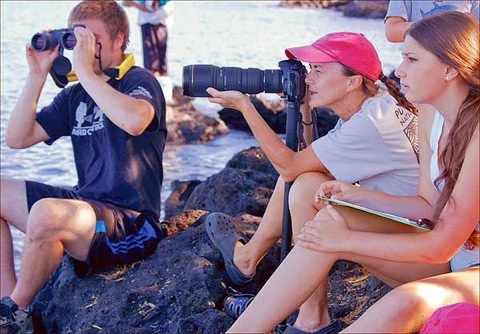
Parker School marine science students traveled to Pelekane Bay on Oct. 2 to observe blacktip reef sharks. The field trip provided the students with an opportunity to do research in conjunction with Hawaii Marine Mammal Consortium.
On January 25th, HMMC board member Susan Rickards gave a ReefTalk on spinner dolphins at the Kealakehe High School. Susan presented research results concerning the life history and behavioral ecology of spinner dolphins, including recent genetic results, comparing spinners in the main islands to northwestern atoll communities. She shared unique observation experiences studying a small community of spinner dolphins at Midway Atoll in the Northwestern Hawaiian Islands. Rickards also reported on recent studies of Big Island dolphins and address the status of a collaborative photo-identification catalog effort of spinners in the greater Pacific Islands Region.
The Cornell Earth and Environmental Systems Field Program
This year, the curriculum for the Cornell Earth and Environmental Field Program had a more even balanced presentation. The program included lectures on humpback whale and spinner dolphin biology as well as combined lectures and workshops on the topics of photogrammetry, spectral estimation and sound analysis.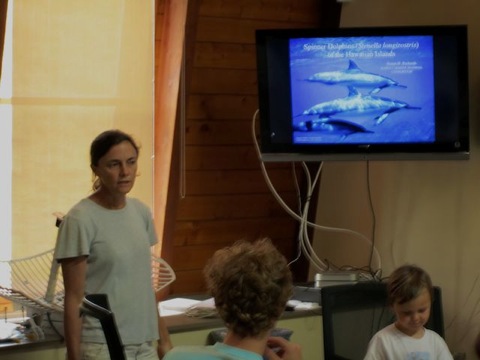
Field trips included HMMC board members Adam Frankel, Chris Gabriele and Susan Rickards (with able assistance from seasoned assistants Mele and Noa Rickards) taught a large class of 20 students shore station techniques at Old Ruins. The students also took a whale-watch cruise, recorded whale song and were able to watch a mother-calf pod as well as a competitive group. Later the students examined songs from 2009, 2010, and the song collected on their whale-watch. They were able to discern that some song units were largely preserved over the three year span, while new units had been introduced in the 2011 song. 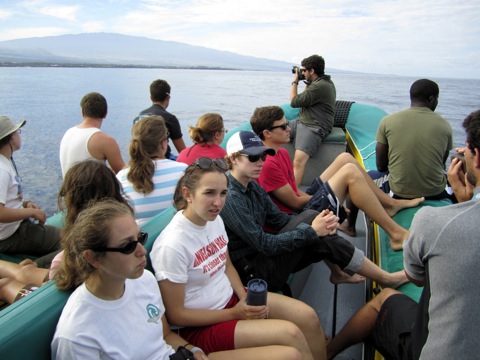
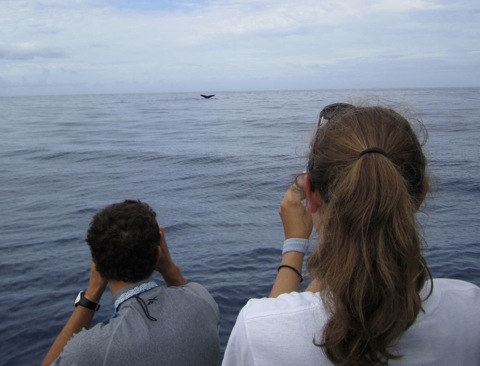
Victor Wooten (a five-time Grammy winner and fellow educator), visited Old Ruins shore station with his family during one of the HMMC’s shore station scans. Victor’s home schooled children took the opportunity to learn more about field research techniques, cetacean behavioral ecology and the ecology of the Hawaiian Islands. 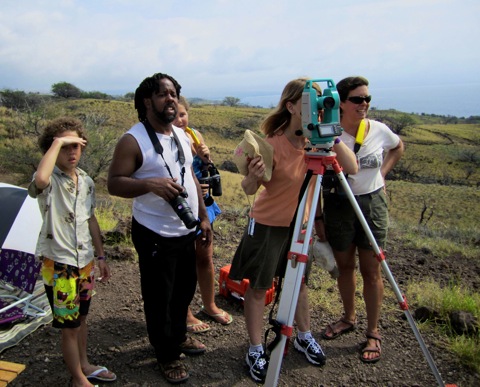
2010
Spinner Dolpin Lecture
On November 29, 2010, HMMC board member Susan Rickards gave a free public program on spinner dolphins at the University of Hawai‘i at Hilo’s North Hawai‘i Education and Research Center (NHERC) in Honokaa. The talk was very well attended by both local residents and students from nearby UH Hilo. Susan showed some beautiful images of spinner dolphins from both Midway Atoll, where she was a lead researcher for several seasons, as well as off the Big Island, where the HMMC has conducted spinner dolphin photo-identification for several years.
Blacktip Reef Sharks of Pelekane Bay
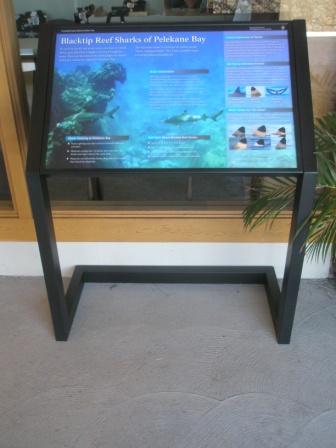
For the last several years, HMMC has been photographing and photo-identifying blacktip reef sharks in Pelekane Bay, near the Pu'ukohola Heiau. Recently we worked with the National Park Service to create an educational sign for the Pu'u Kohola National Historical Site. A detailed version of the kiosk can be downloaded here.
The shark (manō in Hawaiian) is an important figure in Hawaiian culture, religion and oral history. Manō are one of the animals in which an ancestral guardian spirit (‘aumakua) might manifest itself. The remains of Hale o Kapuni Heiau, a sacred temple (heiau) dedicated to the sharks, are submerged in the waters of Pelekane Bay.
The Cornell Earth and Environmental Systems Field Program
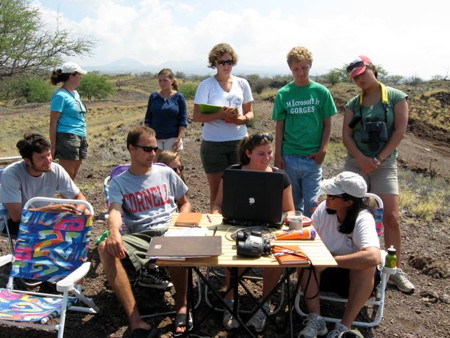
This year, the HMMC curriculum focused on the acoustic behavior of singing humpback whales, in addition to introductory topics such as an overview of the biology of humpback whales, the impact of anthropogenic sound on marine animals and spectral analysis techniques. After making it through the lectures, the students were rewarded with a day on the water, recording singers from a charter vessel. The students later analyzed these recordings in the lab.
The class also incorporated a field component at the Old Ruins shore station, learning shore station techniques, including the use of the theodolite and compass-bearing binoculars. After learning the HMMC research protocols from boardmembers, Adam, Chris, Susan and Yin, the class conducted a full scan session, collecting data that will be used in future analyses. See below for more details on our continuing collaboration with Cornell University’s Hawai‘i Field Program.
University of Hawai’i at Hilo and University of Alaska-Southeast
Board members Chris and Yin ventured over to the Hilo side for two days to teach five university students from Alaska participating on a USDA Alaska Native and Native Hawaiian exchange. On day 1, the group met up at the harbor to participate on a whale watch on the University of Hawai‘i at Hilo’s new research vessel. Led by Dr. Jason Turner, assistant professor at UH Hilo, the group gamely pressed on through very large swells and driving rain, and were rewarded by very close approaches by three (?) humpback whales. Many digital images were taken, including several fluke images to be used for photo-identification of individuals. Chris did a fluke-matching laboratory in the afternoon and several intra- and inter- year matches were made.
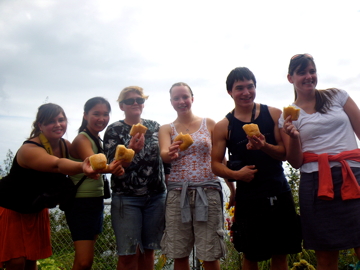
Board member Adam met up with the group on the second day, bearing a box of freshly baked malasadas. Yin explained shore station techniques and theodolite tracking to the sugar-powered students, and then Jason took us all on a tour of the new marine mammal stranding facilities. Later, Adam gave a lecture on humpback whale behavior and acoustics and then the group moved into the lab for a hands-on acoustics laboratory exercise.
2009
Carrie Weedon Science Center Presentation
Adam Frankel kicked off the 2009 Lecture series at the Carrie Weedon Science Center in Galesville, MD with a two-hour overview of the biology and behavior of humpback whales, and answered a wide variety of questions from community members.
WhaleQuest
Chris Gabriele presented a talk at the WhaleQuest meeting on Maui on February 14, 2009 entitled: “Life-Spans and Life Histories of Humpback Whales”. She described past whale age-determination methods and new techniques that may soon allow scientists to estimate the age of live, free-ranging whales. This presentation also showed how long-term sighting histories of individually-identified whales in Alaska and Hawai‘i have shed light on the question of whale age and longevity.
The Cornell Earth and Environmental Systems Field Program
This year HMMC prepared a curriculum focused on the acoustic behavior of singers and the sizing of animals, in addition to introductory topics such as an overview of the biology of humpback whales, the impact of anthropogenic sound on marine animals and spectral analysis techniques. See below for more details on our continuing collaboration with Cornell University’s Hawai‘i Field Program.
Public Presentation
Chris Gabriele gave a ReefTalk titled, "The Long and Interesting Lives of Humpback Whales" at the Thelma Parker Library in Waimea on February 10 and on March 10 at Kealakehe High School. For decades, scientists have been unable to answer a very simple question about humpback whales - How long do they live? Chris’ talk drew over 70 people on each night, with an extensive question and answer session after each presentation.
University of Hawai’i at Hilo
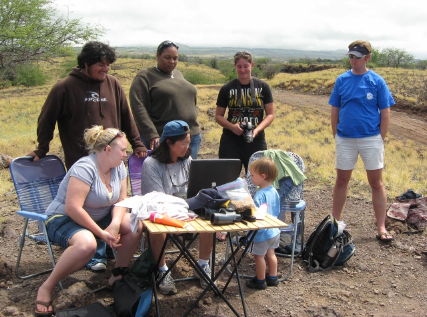
UHH professor Jason Turner brought a group of his undergraduate students enrolled in a marine mammal biology course to the HMMC shore observation station to learn about theodolite data collection and scan sampling procedures.
Elementary School Presentation
In February, board member, Chris Gabriele, spoke with first graders at the Jewish Primary Day School of the Nation's Capital about whales, remotely using “Skype”.
2008
The Cornell Earth and Environmental Systems Field Program
HMMC again helped to teach the bioacoustics portion of the Cornell Hawai’i Field program. In mid-March, 2008, HMMC board member Adam S. Frankel, Ph.D. (also a Senior Scientist for Marine Acoustics, Inc.) taught a two-day acoustics lesson on marine mammal passive acoustics for students from Cornell University. For 2008, the field work resumed on the North Kohala coast. Undergraduate students studied marine mammal field recording and data collection techniques, marine mammal signal processing, localization theory basics, and humpback whale biology.
Elementary School Presentation
Board member, Chris Gabriele, gave a presentation on whale identification at Waimea Middle School to Mrs. Lily Edmunds' 6th grade class.
University of Alaska, Southeast/Mount Edgecumbe School
In 2008 HMMC hosted six native Alaska high school students and one college student (?) from the University of Alaska Southeast and Mount Edgecumbe High School. This year we built upon previous year’s work with photographic identification of individuals, shore station techniques, mark-capture exercises, fluke matching, and a whale-watch trip off Hilo on the University of Hawai‘i Hilo’s research vessel.
2007
Elementary School Presentation
On June 8, 2007, World Ocean Day, Yin spoke to students and teachers at the Smith College Campus School, June Program (K1). The talk was organized by teachers Mr. Henard and Ms. Del Monte and parent Melissa Koester (mom of Zachary). Twenty 5-7 year olds and 4 adults heard Yin’s talk on whales, dolphins and other marine life, and listened to cetacean vocalizations. The students asked lots of questions and were very eager to share their own experiences about the marine environment.
We also hosted a group of Japanese students led by Satoru Yammamoto
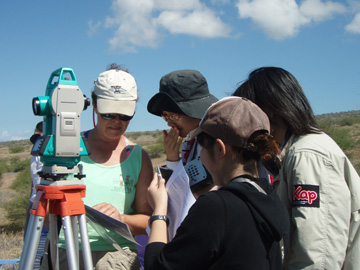
HMMC member Chris Gabriele instructs students on the use of a theodolite to track whales and dolphins
Students from the University of Alaska Southeast
In March 2007, HMMC worked in collaboration with whale researcher Jan Straley from the University of Alaska Southeast, Sitka Campus, (UAS) to involve Alaska high school and university students in our studies of whale migration patterns and behavior. The work was funded by a grant from the Cooperative State Research Education and Extension Service (CREES) program under the U. S. Department of Agriculture. Two of the six Alaska students who were chosen to participate were students at Sheldon Jackson University, and the remaining four were native Alaskan students at Mount Edgecumbe High School. We accompanied the group on a whale watching cruise aboard the University of Hawai‘i Hilo’s research vessel to record humpback whale song and learn about field techniques for observing and taking identification photographs of whales. In West Hawai‘i, we taught shore-based whale observation techniques to the students and provided hands-on laboratory sessions for them to learn about acoustic analysis of whale songs and matching whale identification photographs to the southeastern Alaska whale catalog.
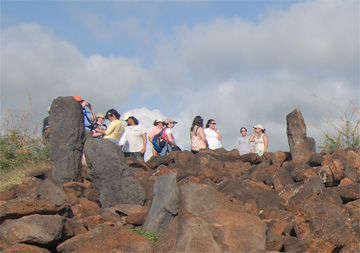
Lehua Wong-WIlson lectures on Hawaiian Navigation Methods to students from the University of Alaska Southeast. They are at the Ko'a Heiau Holo Moana, a navigational heiau.
Cornell University Students
The Cornell Earth and Environmental Systems Field Program
In mid March, 2007, HMMC board member Adam S. Frankel, Ph.D. (also a Senior Scientist for Marine Acoustics, Inc.) taught a two-day acoustics lesson on marine mammal passive acoustics for students from Cornell University. For 2007, the field work resumed on the North Kohala coast. Undergraduate students studied marine mammal field recording and data collection techniques, marine mammal signal processing, localization theory basics, and humpback whale biology. We were also joined briefly by the students from the University of Alaska Southeast during the field work, so these students were able to hear humpback whale song that was transmitted from the sonobuoy system.
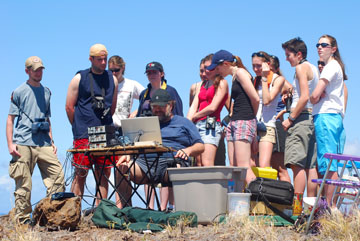
Students from Cornell University examine realtime sonograms from a hydrophone array off the Kohala coast
Preschool Presentation
For the second consecutive year, Susan Rickards presented a talk in August about humpback whales and spinner dolphins at the "Tutu and Me" traveling preschool for children aged 0-5 in Waimea.
Public Presentation
HMMC board member Susan Rickards gave a ReefTalk entitled: "Identifying Hawai'i's Marine Mammals” at the Thelma Parker Memorial Library, Waimea, Hawai‘i. The talk was in November and was sponsored by University of Hawai‘i Sea Grant College Program, School of Ocean and Earth Science and Technology
2006
Students from the Cornell Earth and Environmental Systems Field Program and University of Hawai'i at Hilo
In mid March, 2006, HMMC board member Adam S. Frankel, Ph.D. (also a Senior Scientist for Marine Acoustics, Inc.) taught part of a three-day mini-course on marine mammal passive acoustics for students involved in the Cornell University Hawai‘i-based Marine Ecosystems Field Course. For 2006, the field work moved from Honokohau Bay to the North Kohala coast. Students from Cornell and UH Hilo participated in the field work. Graduate and undergraduate students studied marine mammal field recording and data collection techniques, marine mammal signal processing, localization theory basics, and humpback whale biology.
Public Lecture Spinner dolphins of the Northeast Hawaiian Islands
Susan Rickards presented her unique observations and current research on the behavioral ecology, life history, population dynamics and Inter-atoll movements of Hawaiian spinner dolphins.
Public Outreach
Susan Rickards presented a talk about humpback whales and spinner dolphins at the "Tutu and Me" travelling preschool for children aged 0-5 in Waimea.
Radio Interview
Susan Rickards was interviewed live on a local Hilo radio station, KHBC Radio, 1060 AM. On the Mel "Mynah Bird" Medeiros morning show, Susan discussed the role of the HMMC in the community, the sightings of the entangled whales and the SPLASH field work effort.
Newspaper article
A full-page, color photograph, depicting Suzanne Yin and Chris Gabriele observing whales at the shore station and an extensive accompanying article, was printed in the West Hawaii Today, describing volunteer involvement (featuring our long-time local volunteer, Holly-Sargeant Green) in our shore station work.
Public Outreach
Susan Rickards presented her unique observations and current research on the behavioral ecology, life history, population dynamics and Inter-atoll movements of Hawaiian spinner dolphins in the Northwestern Hawaiian Islands. This public presentation at Mokupapapa Discovery Center, Hilo, Hawai‘i, was sponsored by the the Northwestern Hawaiian Islands Coral Reef Ecosystem Reserve.
2005
Presentation to Brown University Students
HMMC worked with the non-profit Kohala Center and Brown University to provide Brown University undergraduates involved in a 10-day marine biology program a two-hour presentation on whale and dolphin biology and research methods at their Ke’ei Beach field camp.
High School Presentation
HMMC again worked with the non-profit Kohala Center and Brown University to provide highschool students involved in the Brown Environmental Leadership Lab (BELL) program a three-hour presentation on whale and dolphin biology and research methods at their Ke’ei Beach field camp. Twenty high school students, five of these from Hawai‘i Island, and fifteen students from towns and cities across the rest of the United States were involved. BELL is a unique outdoor learning laboratory the goal of which is to provide students with the knowledge, attitudes and skills needed to become effective leaders, build a supportive community, and protect the world around them.
The Cornell Earth and Environmental Systems Field Program
In early March, 2005, HMMC board member Adam S. Frankel, Ph.D. (also a Senior Scientist for Marine Acoustics, Inc.)taught part of a three-day mini-course on marine mammal passive acoustics for students involved in the Cornell University Hawai‘i-based Marine Ecosystems Field Course. Graduate and undergraduate students studied marine mammal field recording and data collection techniques, marine mammal signal processing, localization theory basics, and humpback whale biology. Students also gained hands-on experience deploying and retrieving sonobuoy recording systems at sites off the coast of the Big Island
Kona Outdoor Circle whale watches
In January, February and March of 2004 and 2005, HMMC board members represented HMMC as volunteer naturalists aboard benefit public whalewatches for the Kona Outdoor Circle. Participation was extremely high, with some cruises in 2005 having well over 200 passengers. We sighted humpback whales, bottlenose dolphins and spinner dolphins from the Captain Bean’s vessel, all while being serenaded by John Kiawe, who provided his customary excellent guitar playing. We were able to photograph two humpback whale flukes during these trips, which will be incorporated into the SPLASH data that we submit for the North Pacific catalog.
On 6 January 2005, as an active volunteer in the West Hawai‘i chapter of the Hawaiian Islands Stranding Response Group (HISRG), HMMC board member Susan Rickards provided a presentation to train HISRG volunteers on marine mammal species identification. HISRG is a non-profit organization, led by Bob Braun DVM, Marlee Breese and Paul Nachtigall (an HMMC advisor), that aims to organize and be ready to respond to marine mammal strandings in the Hawaiian Islands.
2004
Public Presentations
HMMC was pleased and honored to present educational ReefTalks, co-sponsored by the Hawaiian Islands Humpback Whale National Marine Sanctuary and the University of Hawai‘i Sea Grant College Program, School of Ocean and Earth Science and Technology. ReefTalks are free public service presentations, held monthly, alternating between the Waimea/Kamuela and Kona areas of the island of Hawai‘i. For more information, call UH Sea Grant Extension Service at 808-329-2861.
* 20 January 2004, HMMC board member Chris Gabriele (also a wildlife biologist at Glacier Bay National Park), presented a talk entitled: “The Not-So-Silent Underwater World of the Humpback Whale”. Chris, with 16 years of research and observation experience, discussed her acoustic work and described and played examples of whale and vessel noise. Kealakehe High School library, Kailua-Kona
* 24 February 2004, HMMC board member Suzanne Yin presented a talk entitled: “What Was Learned during the Hawaiian Islands Cetacean and Ecosystem Assessment Survey?” Yin has wandered the world studying marine mammals and her accumulated knowledge gives her a global perspective. Yin presented findings from the 2002 NOAA marine mammal survey around the Hawaiian island chain. This study documented 24 different species, including two not previously recorded in Hawai‘i. She also gave an overview of the new international humpback whale study know as "SPLASH”. Thelma Parker Memorial Library at Waimea School, Kamuela/Waimea
The Cornell Earth and Environmental Systems Field Program
In early March, 2004, HMMC board member Adam S. Frankel, Ph.D. (also a Senior Scientist for Marine Acoustics, Inc.) taught part of a three-day mini-course on marine mammal passive acoustics for students involved in the Cornell University Hawai‘i-based Marine Ecosystems Field Course. Graduate and undergraduate students studied marine mammal field recording and data collection techniques, marine mammal signal processing, localization theory basics, and humpback whale biology. Students also gained hands-on experience deploying and retrieving sonobuoy recording systems at sites off the coast of the Big Island
College Internship
As a student in the Cornell University field course in Earth and Environmental systems, Melissa Duhaime trained under and worked extensively with Susan Rickards on HMMC SPLASH research data entry and photo-analysis. These internships were designed to provide the students with the opportunity to give something back to the island community which hosted them for three-months, while at the same time adding depth to their learning experience by having them work closely with island scientists and cultural scholars.
College Presentation
On 16 July 2004, board member Susan H. Rickards conducted a two-hour presentation, followed by a three-hour laboratory session, for a University of Hawai‘i at Hilo college-level course on Marine Mammals. The presentation included an overview of ongoing cetacean research in Hawai‘i, research methodologies and findings, as well a discussion of humpback whale ecology. The laboratory involved a demonstration of shore-based cetacean tracking methodologies involving the use of a theodolite and computer-based data retrieval.
Educational Presentation
In July of 2004, HMMC board member Adam S. Frankel, flew to Seacamp at Newfound Harbor Marine Institute and gave an educational presentation on Hawaiian Humpback Whales to the campers there. Seacamp is a non-profit, marine science education facility located on in the Florida Keys, which offers marine science education and camp experiences to students from 4th grade through college level, as well as teachers.
Presentation to Kawaihae Local Resource Council
HMMC board member Susan Rickards gave a brief presentation describing our organization and activities including SPLASH research to the Kawaihae Local Resource Council (Harbor Hui) at 1400 hr at the Kawaihae Canoe Club. Among approximately 10 attendees were Representative Cindy Evans and Councilman Leningrad Elarionoff.
2003
Kona Outdoor Circle Whale Watches
Susan Rickards represented HMMC as a naturalist aboard four benefit public whale watches for the Kona Outdoor Circle in January and February
Television Appearance
In February, Chris Gabriele appeared on “live” public television show “Kid Science” hosted by Patty Miller and spoke about whales in Glacier Bay and HMMC’s work off the Big Island, including re-enactment of how a sonobuoy array allows researchers to locate singing whales.
Explorer’s Club
HMMC hosts Explorers Club expedition (eight volunteers) for participation in shore-based scans and acoustic monitoring.
Public Presentations
7 March 2003 Adam Frankel and Chris Gabriele gave a public presentations on humpback whale natural history and research in Hawai‘i and Alaska, targeted for educators, marine naturalists and the general public at Waikoloa School.
9 March 2003 HMMC hosts 45 members of the general public at “Listen to the Whales Day” at our shore site. Participants heard live whale song radioed back to shore by 3 sonobuoy hydrophones and observed a singer when it surfaced, and saw demonstration of the use of a theodolite.
21 April 2003, 7:00-9:00pm, HMMC board member Susan Rickards gave an invited talk in Hilo, sponsored by the Hawaiian Islands Humpback Whale National Marine Sanctuary and the Northwestern Hawaiian Islands Coral Reef Ecosystem Reserve, on HMMC research and conservation. The talks was entitled, "Hawai‘i Marine Mammal Consortium Humpback Whale Studies in Kawaihae Bay." S. Hata Building, Suite 105, Downtown Hilo
1 July 2003, 6:30pm to 8:30pm, HMMC board member Susan Rickards gave a ReefTalk sponsored by University of Hawai‘i Sea Grant College Program, School of Ocean and Earth Science and Technology entitled: “Hawaiian Spinner Dolphins of Midway Atoll”. Thelma Parker Memorial Library, Kamuela, Hawai‘i.
ReefTalks are free public service presentations
Susan discussed findings from her recent work as Principal Field Researcher for the Oceanic Society's investigations of spinner dolphins inhabiting Midway Atoll in the Northwest Hawaiian Islands. Her research included population biology, behavioral ecology, and social organization of spinner dolphins in the region. Ms. Rickards shared some of her unique observations, what is being learned from this study, and collaborations with other researchers.
In February and March of 2003 and 2004, high school students from the West Hawai‘i Explorations Academy (WHEA) charter school participated in HMMC’s shore-based research of marine mammals from the “Old Ruins” site on the Kohala Coast. They were given an overview of the research goals and methodology and then taught to assist in the collection of scan data. WHEA is a project-based learning laboratory for 7th - 12th grade students. It is the first Public Charter High School in Hawai‘i. WHEA students participate in scientific research and commercial operations. Rather than attending classes, students receive credit for all of their core courses by managing and staffing a wide variety of projects. They collaboratively team with peers, staff, University of Hawai‘i faculty and students, mentors, community members, and employers. WHEA helps students learn how to learn, and learn how to collaborate, skills that prepare students for their future.
2002
Under the guidance of HMMC researchers, three local high school students, several community college students and thirteen members of an Explorer’s Club expedition participated in the data collection. We also make the data available to high school students and teachers who are learning GIS (Geographic Information System) techniques through a collaboration with Alan Nakagawa of Honoka’a High School.
2001
Public Presentations
Hawaiian Islands Humpback Whale National Marine Sanctuary and the Hawai'i Marine Mammal Consortium provided a series of free public lectures in 2001.
* 13 February, 2001, 7:00 pm, HMMC board member Chris Gabriele (also a wildlife biologist at Glacier Bay National Park) presented a talk entitled: “Humpback Whale Behavior in Alaska and Hawai'i: Similarities and Differences.”. Kealakehe High School – library, Kailua-Kona
* 27 February 2001, 7:00 pm, HMMC board member Susan Rickards presented a talk entitled: “Spinner Dolphins of Midway Atoll.” Kealakehe High School – library, Kailua-Kona
* 6 March 2001, 7:00 pm, HMMC board member Adam Frankel, Ph.D. presented a talk entitled, "What We Can Learn From Humpback Whale Sounds." Kealakehe High School – library, Kailua-Kona